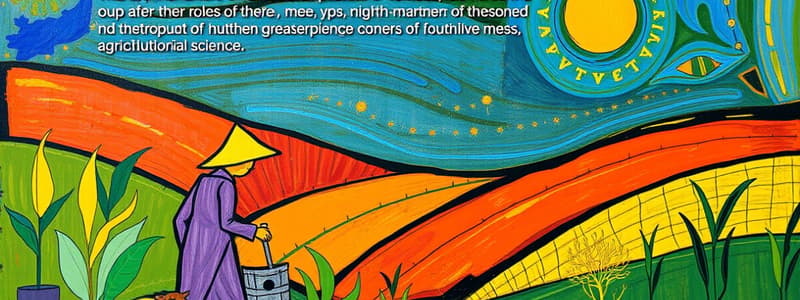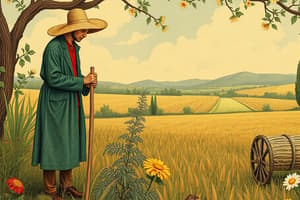Podcast
Questions and Answers
What is your definition of agriculture?
What is your definition of agriculture?
How does the average American use agriculture every day?
How does the average American use agriculture every day?
Explain the job of a farmer and what you think they do every day.
Explain the job of a farmer and what you think they do every day.
What are the basic human needs?
What are the basic human needs?
How can agriculture help you meet your basic needs?
How can agriculture help you meet your basic needs?
The average American consumes __________ (e.g., corn, soybeans) and uses __________ (e.g., cotton, leather) from agriculture.
The average American consumes __________ (e.g., corn, soybeans) and uses __________ (e.g., cotton, leather) from agriculture.
Which of the following is NOT a basic human need?
Which of the following is NOT a basic human need?
What percentage of the meat consumed is from swine (pork)?
What percentage of the meat consumed is from swine (pork)?
Which item is NOT a product that comes from agriculture?
Which item is NOT a product that comes from agriculture?
Cattle and calves are among the top 10 agricultural commodities in the US.
Cattle and calves are among the top 10 agricultural commodities in the US.
Name a by-product of field corn.
Name a by-product of field corn.
Many crayons are made with up to 85% __________ oil.
Many crayons are made with up to 85% __________ oil.
Which of the following items can contain corn derivatives?
Which of the following items can contain corn derivatives?
List three agricultural commodities produced in Indiana.
List three agricultural commodities produced in Indiana.
Bioplastics represent a significant majority of all plastic produced annually.
Bioplastics represent a significant majority of all plastic produced annually.
Which of the following food items does NOT come from agricultural sources?
Which of the following food items does NOT come from agricultural sources?
What percentage of the poultry consumed in the average American diet is derived from chicken?
What percentage of the poultry consumed in the average American diet is derived from chicken?
Which of the following dairy products is NOT typically produced from agriculture?
Which of the following dairy products is NOT typically produced from agriculture?
Which livestock type contributes the least percentage of total meat consumption in the average American diet?
Which livestock type contributes the least percentage of total meat consumption in the average American diet?
Which of the following activities is most likely to involve agriculture during a typical weekday?
Which of the following activities is most likely to involve agriculture during a typical weekday?
Study Notes
Definition of Agriculture
- Agriculture encompasses the cultivation of plants and livestock for food, fiber, and other products used to sustain and enhance life.
Average American's Daily Use of Agriculture
- Food consumption includes fruits, vegetables, grains, meats, and dairy—all derived from agricultural practices.
- Clothing made from cotton, wool, and leather involves agricultural resources.
- Shelter materials like lumber and insulation stem from agricultural by-products.
Job of a Farmer
- Farmers cultivate land, plant seeds, manage crops, and care for livestock.
- Daily tasks often include maintenance of equipment, monitoring plant growth, and ensuring livestock health.
- Farmers also manage financial aspects, such as budgeting and selling produce.
Basic Human Needs
- Food: Essential for nutrition and survival.
- Shelter: Provides safety and protection from elements.
- Clothing: Necessary for warmth and social functionality.
Agriculture's Role in Meeting Human Needs
- Agriculture supplies food staples, like grains and meats, which fill nutritional gaps.
- Provides materials for shelter, including wood and insulation derived from plants and animals.
- Produces fibers for clothing, ensuring availability throughout the seasons.
Food Categories
- Meat: Top sources include pork (36%), poultry (33%), and beef (24%).
- Dairy: Includes milk, cheese, yogurt, and related products.
- Fruits: Notable world consumption figures: tomatoes (182 million metric tons), bananas (115.74 million metric tons).
- Vegetables: Major vegetables consumed include onions (93.17 million metric tons) and cucumbers (71.26 million metric tons).
- By-Products: All food products, including processed items, originate from agriculture.
Shelter Materials from Agriculture
- Lumber: Worth over $200 billion annually; sourced from 823 million acres of forests in the U.S.
- Plastics: Biobased plastics are produced from renewable sources; constitute less than 1% of annual plastic production.
- Insulation: Made from recycled paper, cotton, sheep's wool, and natural fibers.
- Carpets: Mainly synthetic but include some natural materials like wool and cotton.
Key Agricultural Commodities in the U.S.
- Major commodities include cattle & calves (cash receipts of 72.87billion),corn(72.87 billion), corn (72.87billion),corn(71.1 billion), and soybeans ($48.61 billion).
- Specifics about Indiana's agricultural output indicate strong production of corn, soybeans, and hogs.
Surprising Uses of Agriculture
- Consumer Products: Items like crayons (85% soybean oil), diapers (corn by-products), and makeup (corn starch) derive from agriculture.
- Everyday Items: Household products such as soap, toothpaste, and adhesive materials often contain agricultural ingredients.
- Innovative Uses: Cornstarch is utilized in various products, including aspirin and rubber tires, highlighting agriculture's role in modern manufacturing.
Daily Schedule and Agricultural Connections
- Activities throughout one's day can often be linked to agricultural products, from breakfast foods to clothing worn, emphasizing agriculture's pervasive influence.
Definition and Role of Agriculture
- Agriculture is the practice of cultivating soil, growing crops, and raising animals for food, fiber, and other products.
- It is essential for meeting basic human needs: food, shelter, and clothing.
Daily American Use of Agriculture
- Agricultural products are integrated into daily life, from food consumed at meals to materials used in clothing and shelter.
- Examples include vegetables, fruits, dairy, grains, and proteins sourced from farming.
Role of Farmers
- Farmers are responsible for planting, cultivating, and harvesting crops and raising animals.
- Everyday tasks include managing land, ensuring animal health, handling equipment, and addressing environmental factors.
Basic Human Needs Addressed by Agriculture
- Food requirements: includes meat, dairy, fruits, vegetables, and various by-products.
- Shelter materials: derived from agriculture like lumber, plastics (biobased), and insulation options.
- Clothing materials: products such as cotton, wool, linen, and leather all stem from agriculture.
Major Food Sources
- Meat consumption is diverse:
- Pork (36%), chicken and turkey (33%), beef (24%), sheep and goat (5%).
- Dairy products include milk, cream, cheese, butter, yogurt, and ice cream.
- Eggs from chickens, quails, ducks, and other birds contribute significantly to diets.
- Fruits and vegetables are vital, with global consumption numbers indicating high figures:
- Tomatoes (182 million metric tons), bananas (115.74 million metric tons), onions (93.17 million metric tons).
Agricultural Commodities
- Commodities are raw materials from agriculture that are traded for further production; field corn and cattle serve as examples.
- Top agricultural commodities in the US highlight the economic significance, with cattle & calves, corn, and soybeans ranking high by cash receipts.
Indiana's Agricultural Landscape
- Major commodities include corn ($5.05 billion) and soybeans ($3.83 billion), reflecting extensive acreage and production.
- Hogs and dairy products also rank among the top, depicting significant livestock farming in the state.
- Indiana consistently ranks in the top ten nationally for various agricultural outputs, demonstrating its key role in the US agricultural sector.
Agricultural Products
- Defined as goods produced and marketed for consumption; finished products result from processing raw commodities.
- Examples include how field corn transforms into livestock feed and other consumables.
Environmental and Economic Impact
- Agriculture contributes heavily to the economy, with industries like timber generating over $200 billion annually.
- Sustainable options in agriculture include bioplastics made from renewable resources, enhancing environmental responsibility.
Studying That Suits You
Use AI to generate personalized quizzes and flashcards to suit your learning preferences.




